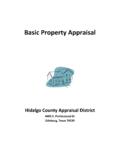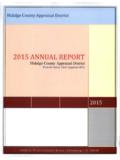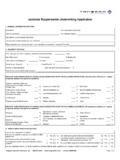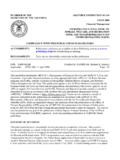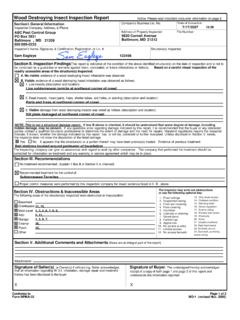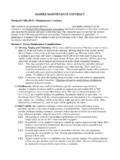Transcription of Application for 1-d-1 (Open-Space) Agricultural Use …
1 Texas Comptroller of Public AccountsForm 50-129 The Property Tax Assistance Division at the Texas Comptroller of Public Accounts provides property tax information and resources for taxpayers, local taxing entities, appraisal districts and appraisal review more information, visit our website: 1-18/16 Application for 1-d-1 (Open-Space) Agricultural Use Appraisal_____ _____Appraisal District s Name Phone (area code and number)_____Address, City, State, ZIP CodeGENERAL INFORMATION: Texas Constitution, Article VIII, Section 1-d-1 , and Tax Code, Chapter 23, Subchapter D, provide for appraisal of open-space land. The Comptroller s Manual for the Appraisal of Agricultural Land on the Comptroller s website provides information regarding applying for special appraisal, qualification requirements and additional taxes and penalties created by a changes of land use. Local appraisal district staff can answer questions regarding these INSTRUCTIONS: This Application and all supporting documentation must be filed with the appraisal district office in each county in which the property is located so that the chief appraiser is able to determine whether the statutory qualifications have been met.
2 Do not file this document with the Texas Comptroller of Public Accounts. A directory with contact information for appraisal district offices may be found on the Comptroller s DEADLINES: The completed Application must be filed with the chief appraiser before May 1 of the year for which Agricultural appraisal is requested. If the Application is approved, a new Application is not required in later years unless the land ownership changes, eligibility ends or the chief appraiser requests a new Application . A late Application may be filed up to midnight the day before the appraisal review board approves appraisal records for the year, which usually occurs in July. If a late Application is approved, a penalty will be applied in an amount equal to 10 percent of the difference between the amount of tax imposed on the property and the amount that would be imposed if the property were taxed at market value. DUTY TO NOTIFY AND PENALTIES: The property owner must notify the chief appraiser no later than the April 30 following the change in use or eligibility.
3 A change of land use for all or part of the property will trigger substantial additional tax plus interest (a rollback tax). Payment of a penalty may also be required for failure to notify the chief appraiser of a change in Agricultural use or qualification. Notice must be delivered to the chief appraiser if: the property stops being used for agriculture ( , voluntarily stopped farming); category of land use changes ( , from dry cropland to irrigated cropland); level of use changes ( , a substantial increase or decrease the number of cattle raised); nature of use changes ( , a switch from growing corn to growing ornamental plants); property owner enters, leaves or changes governmental programs ( , 100 acres placed in a conservation reserve program); or the land is used for something other than agriculture ( , to build a shopping center on most of the land). DUTY TO NOTIFY FOR CERTAIN LANDOWNERS: If land ceases to be devoted principally to Agricultural use to the degree of intensity generally accepted in the area, open-space appraisal may be retained if the chief appraiser is notified as required and the property owner: is a member of the armed services who is deployed or stationed outside of Texas who intends to return the land to the manner and to the degree ofintensity that is generally accepted in the area not later than the 180th day after being deployed or stationed outside this state ceases.
4 Owns land that has previously been under open-space appraisal primarily based on its citrus production; the land is located in a pest managementzone; and an agreement was executed to destroy, remove or treat all the citrus trees located on the land that are or could become infested withpests with one of the following: Texas Citrus Pest and Disease Management Corporation, Inc., the Texas Commissioner of Agriculture or the of IMPORTANT INFORMATIONIf the initial Application form does not contain all essential information, the chief appraiser may request additional information that is necessary to determine whether the land qualifies for 1-d-1 appraisal. The chief appraiser may disapprove the Application and request additional information. The chief appraiser may deny the Application and that determination may be protested to the county appraisal review board in a timely manner. If the chief appraiser requests additional information from an applicant, the information must be furnished within 30 days after the date of the request, or the Application is denied.
5 For good cause shown, the chief appraiser may extend the deadline for furnishing the information by written order for a single 15 day the year for which Agricultural use appraisal is YearDid the applicant own the property that is the subject of this Application on Jan. 1 of the tax year? .. Yes NoTexas Comptroller of Public AccountsForm 50-129 For more information, visit our website: 250-129 01-18/16 SECTION 1: Property Owner/ApplicantThe applicant is the following type of property owner: Individual Partnership Corporation Other (specify): _____ _____ _____Name of Property Owner Driver s License, Personal Certificate Social Security Number or Federal Tax Number*Provide date of birth if property owner is an individual (Failure to provide date of birth does not affect eligibility for special appraisal.) _____Date of Birth_____Physical Address, City, State, ZIP Code_____ _____Primary Phone Number (area code and number) Email Address**Mailing Address of Property Owner (if different from the physical address provided above):_____Mailing Address, City, State, ZIP CodeSECTION 2: Authorized RepresentativeIf you are an individual property owner filing this Application on your own behalf, skip to section 3.
6 All other applicants are required to complete section indicate the basis for your authority to represent the property owner in filing this Application : Officer of the company General Partner of the company Attorney for property owner Agent for tax matters appointed under Tax Code Section with completed and signed Form 50-162 Other and explain basis: _____Provide the following information for the individual with the legal authority to act for the property owner in this matter:_____ _____Name of Authorized Representative Driver s License, Personal Certificate or Social Security Number*_____ _____ _____Title of Authorized Representative Primary Phone Number (area code and number) Email Address**_____Mailing Address, City, State, ZIP CodeSECTION 3: Property DescriptionProvide the descriptive information requested below for the property that is the subject of this Application or attach last year s tax statement, notice of appraised value or other correspondence identifying the _____Appraisal District Account Number (if known) Number of Acres (subject to this Application ) Legal description, abstract numbers, field numbers and/or plat numbers:Texas Comptroller of Public AccountsForm 50-129 For more information, visit our website: 350-129 01-18/16 SECTION 4: Property InformationSelect the appropriate box in response to each question below.
7 1. Has the ownership of the property changed since Jan. 1 of last year or since the last Application was submitted? .. Yes NoIf yes, the new owner must complete all applicable questions and, if the land is used to manage wildlife, sections 5 and 6 must be Last year, was 1-d-1 appraisal allowed on this property by the chief appraiser of this appraisal district? .. Yes NoIf no, all applicable questions must be completed and, if the land is used to manage wildlife, sections 5 and 6 must be yes, complete only those parts of sections 5 and 6 that have changed since the earlier Application or any information in sections 5 and 6 requested by the chief appraiser. 3. Is this property located within the corporate limits of a city or town? .. Yes NoSECTION 5: Property UseAgricultural use includes, but is not limited to, the following activities: (1) cultivating the soil; (2) producing crops for human food, animal feed, or planting seed or for the production of fibers; (3) floriculture, viticulture and horticulture; (4) raising or keeping livestock; (5) raising or keeping exotic animals or fowl for the production of human food or fiber, leather, pelts or other tangible products having a commercial value; (6) planting cover crops or leaving land idle for the purpose of participating in a governmental program provided the land is not used for residential purposes or a purpose inconsistent with Agricultural use or leaving the land idle in conjunction with normal crop or livestock rotation procedures.
8 (7) producing or harvesting logs and posts used for construction or repair of fences, pens, barns or other Agricultural improvements on adjacent open-space land having the same owner and devoted to a different Agricultural use; (8) wildlife management; and (9) beekeeping. Wildlife management is defined as actively using land that at the time the wildlife-management use began, was appraised as qualified open-space or timberland under Tax Code, Chapter 23, Subchapter D or E, to propagate a sustaining breeding, migrating or wintering population of indigenous wild animals for human use, including food, medicine or recreation, in at least three of the following ways: (1) habitat control; (2) erosion control; (3) predator control; (4) providing supplemental supplies of water; (5) providing supplement supplies of food; (6) providing shelters; and (7) making census counts to determine population. Wildlife management is defined as actively using land to protect federally listed endangered species under a federal permit if the land is included in a habitat preserve subject to a conservation easement created under Natural Resources Code Chapter 183 or part of a conservation development under a federally approved habitat conservation plan restricting the use of the land to protect federally listed endangered species or actively using land for a conservation or restoration project under certain federal and state statutes.
9 These two types of wildlife management uses do not require showing a history of Agricultural use but do require evidence identified in section 6, questions 7 and 8. Agricultural land use categories include: (1) irrigated cropland; (2) dry cropland; (3) improved pastureland; (4) native pastureland; (5) orchard; (6) wasteland; (7) timber production; (8) wildlife management; and (9) other categories of land that are typical in the complete answers to the following questions. List the Agricultural use of the property according to the Agricultural land categories listed in the preceding paragraph. Divide the total acreage according to individual uses to which the land is principally Describe the current and past Agricultural uses of this property as described above, starting with the current year and working back 5 years or until 5out of 7 years of Agricultural use is shown. Five years of continuous Agricultural use may be required if the land is located within the corporate limits ofa city or Use Category of Land (list all that apply)Acres Principally Devoted to Agricultural UseCurrent1234567 Texas Comptroller of Public AccountsForm 50-129 For more information, visit our website: 450-129 01-18/162.
10 (a) List the livestock, exotic animals or exotic fowl raised or the type of wildlife managed on the property and the number of acres used for each activity. Attach a list if the space is not , Exotic or WildlifeNumber of Acres(b)How many head of livestock or exotic animals are raised on the property (average per year)?Livestock or ExoticsNumber of Head3. List the crops grown (including ornamental plants, flowers or grapevines) and the number of acres devoted to each crop. Attach a list if the space is of CropNumber of Acres4. List participation in any government programs for planting cover crops or land lying idle and the number of acres devoted to each program. Attach a listif the space is not NameNumber of Acres5. If the property is now used for any nonagricultural activities, list all nonagricultural uses and the number of acres devoted to each use. Attach a list ifthe space is not UseNumber of AcresSECTION 6: Wildlife Management UseComplete this section only if the land is used for wildlife management.


